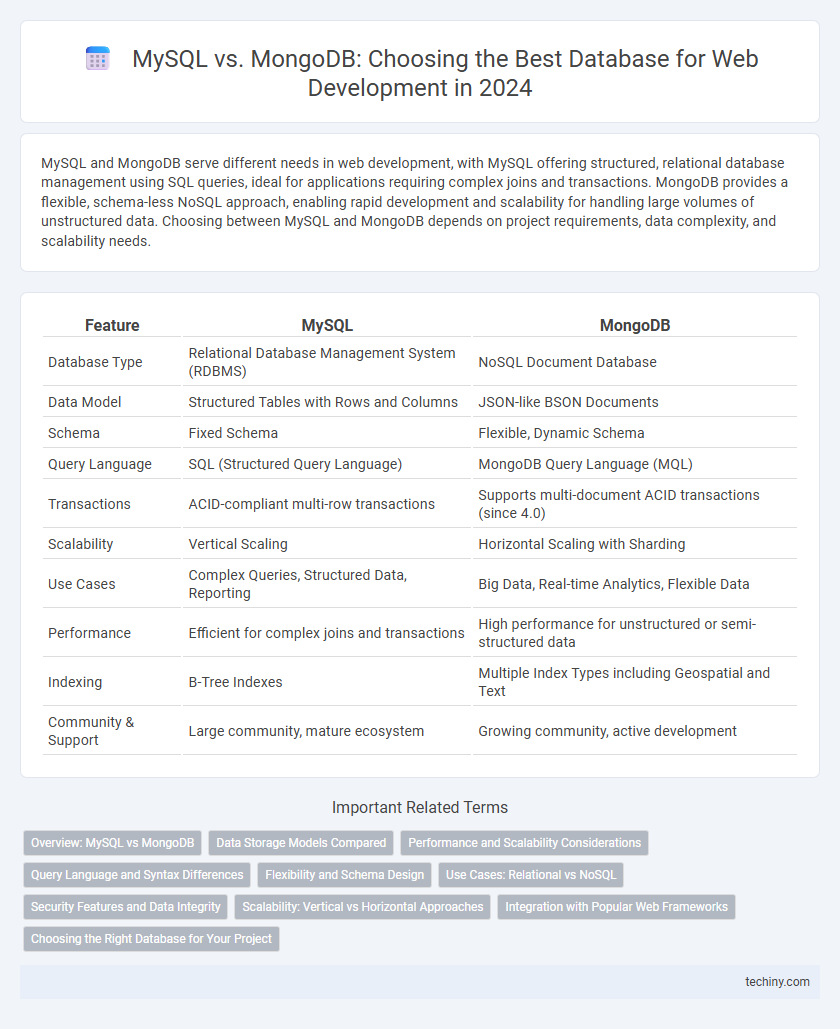MySQL and MongoDB serve different needs in web development, with MySQL offering structured, relational database management using SQL queries, ideal for applications requiring complex joins and transactions. MongoDB provides a flexible, schema-less NoSQL approach, enabling rapid development and scalability for handling large volumes of unstructured data. Choosing between MySQL and MongoDB depends on project requirements, data complexity, and scalability needs.
Table of Comparison
| Feature | MySQL | MongoDB |
|---|---|---|
| Database Type | Relational Database Management System (RDBMS) | NoSQL Document Database |
| Data Model | Structured Tables with Rows and Columns | JSON-like BSON Documents |
| Schema | Fixed Schema | Flexible, Dynamic Schema |
| Query Language | SQL (Structured Query Language) | MongoDB Query Language (MQL) |
| Transactions | ACID-compliant multi-row transactions | Supports multi-document ACID transactions (since 4.0) |
| Scalability | Vertical Scaling | Horizontal Scaling with Sharding |
| Use Cases | Complex Queries, Structured Data, Reporting | Big Data, Real-time Analytics, Flexible Data |
| Performance | Efficient for complex joins and transactions | High performance for unstructured or semi-structured data |
| Indexing | B-Tree Indexes | Multiple Index Types including Geospatial and Text |
| Community & Support | Large community, mature ecosystem | Growing community, active development |
Overview: MySQL vs MongoDB
MySQL is a relational database management system (RDBMS) that uses structured query language (SQL) and supports ACID-compliant transactions, making it ideal for applications requiring complex joins and data integrity. MongoDB is a NoSQL document-oriented database designed for scalability and flexibility, storing data in JSON-like BSON formats, which allows for dynamic schemas and rapid iterative development. Choosing between MySQL and MongoDB depends on specific use cases, with MySQL excelling in structured data environments and MongoDB providing advantages in handling unstructured or semi-structured data.
Data Storage Models Compared
MySQL utilizes a structured relational data storage model based on tables, rows, and columns, enforcing schemas and supporting ACID transactions for consistency and reliability. MongoDB employs a flexible, document-oriented data storage model using JSON-like BSON documents, enabling dynamic schemas and easier handling of hierarchical or unstructured data. The choice between MySQL and MongoDB depends on application needs, with MySQL excelling in complex queries and relational data integrity, while MongoDB offers scalability and agility for evolving data structures.
Performance and Scalability Considerations
MySQL excels in performance for complex queries and structured data with ACID-compliant transactions, making it ideal for relational database tasks. MongoDB offers superior scalability through its flexible schema design and sharding capabilities, efficiently handling large volumes of unstructured and semi-structured data in distributed environments. Web developers choose MySQL for consistent transactional integrity, while MongoDB supports rapid development and horizontal scaling in big data and real-time applications.
Query Language and Syntax Differences
MySQL uses Structured Query Language (SQL), which relies on a rigid schema and predefined tables with clear relational data structures, making it ideal for complex joins and transactions. MongoDB employs a flexible, JSON-like query syntax designed for document-oriented data, allowing dynamic schemas and nested data formats that simplify querying hierarchical data. This contrast in query languages impacts how developers handle data relationships, with MySQL favoring structured query commands and MongoDB offering versatile, object-based querying.
Flexibility and Schema Design
MySQL employs a rigid, predefined schema structure ideal for applications requiring complex joins and transactional integrity, ensuring data consistency through ACID compliance. MongoDB offers a flexible, schema-less design with JSON-like documents, enabling developers to adapt data models rapidly to evolving application needs without downtime. This schema flexibility in MongoDB supports agile development environments by allowing dynamic and hierarchical data structures that are cumbersome to implement in traditional relational databases like MySQL.
Use Cases: Relational vs NoSQL
MySQL excels in use cases requiring structured data and complex relationships, such as financial applications and e-commerce platforms that benefit from ACID transactions and JOIN operations. MongoDB suits projects with flexible schema designs, like content management systems and real-time analytics, where rapid iteration and scalability with unstructured or semi-structured data are critical. Choosing between MySQL and MongoDB depends on the necessity for relational integrity versus schema flexibility and horizontal scaling.
Security Features and Data Integrity
MySQL offers robust security features such as role-based access control, encryption at rest, and SSL/TLS for secure data transmission, ensuring strong data integrity through ACID-compliant transactions. MongoDB supports flexible schema design with built-in encryption, auditing, and authentication mechanisms like SCRAM and LDAP integration, but it relies on eventual consistency models that may impact immediate data integrity. For applications demanding strict transactional integrity and comprehensive security auditing, MySQL is often preferred, while MongoDB caters to scenarios requiring scalable security with flexible, schema-less data storage.
Scalability: Vertical vs Horizontal Approaches
MySQL primarily supports vertical scalability by enhancing hardware capacity like CPU and RAM for improved performance, suitable for applications with structured data and complex queries. MongoDB excels in horizontal scalability through sharding, distributing large datasets across multiple servers, making it ideal for handling big data and unstructured collections. Choosing between these databases depends on the specific scalability needs, data structure, and workload patterns of the web application.
Integration with Popular Web Frameworks
MySQL seamlessly integrates with popular web frameworks like Django, Laravel, and Ruby on Rails through native ORM support, enabling efficient database management and query optimization. MongoDB's flexible schema aligns well with Node.js and Express.js, facilitated by libraries such as Mongoose for schema modeling and validation. Both databases offer robust community plugins and tools that simplify integration, but the choice depends on the application's data structure and scalability requirements.
Choosing the Right Database for Your Project
Choosing the right database for your project hinges on understanding the strengths of MySQL and MongoDB. MySQL excels with structured data and complex queries due to its relational model and ACID compliance, while MongoDB offers flexibility with unstructured or semi-structured data through its NoSQL, document-oriented architecture. Prioritize MySQL for transactional systems requiring data integrity, and opt for MongoDB when scalability and rapid iteration with evolving data schemas are critical.
MySQL vs MongoDB Infographic

 techiny.com
techiny.com